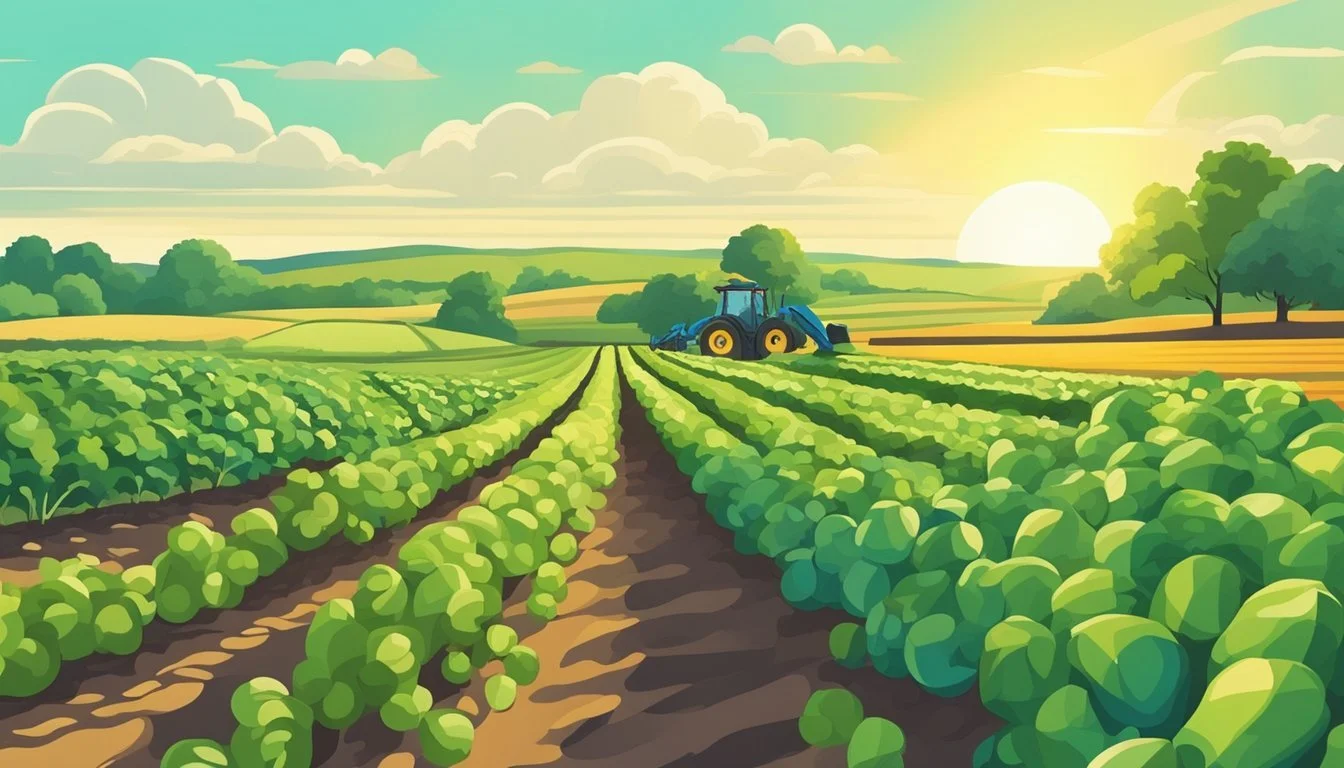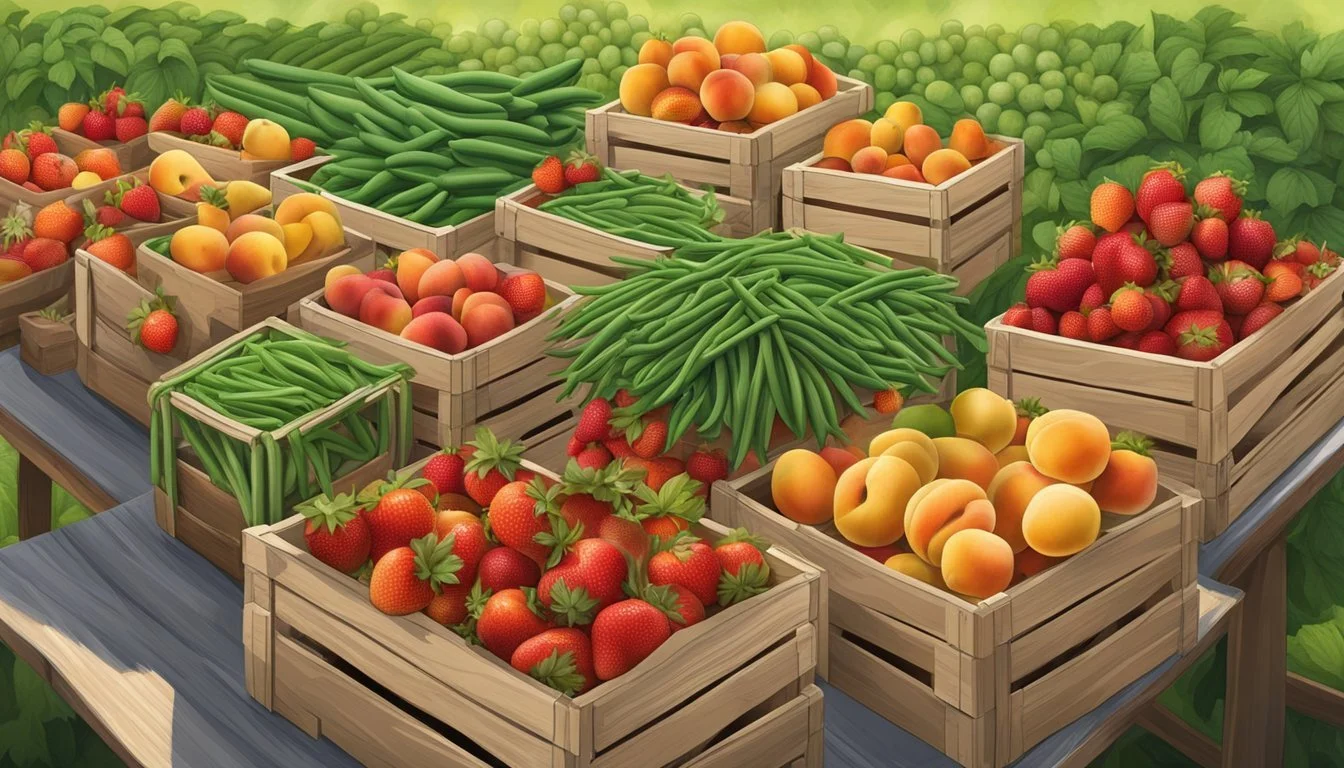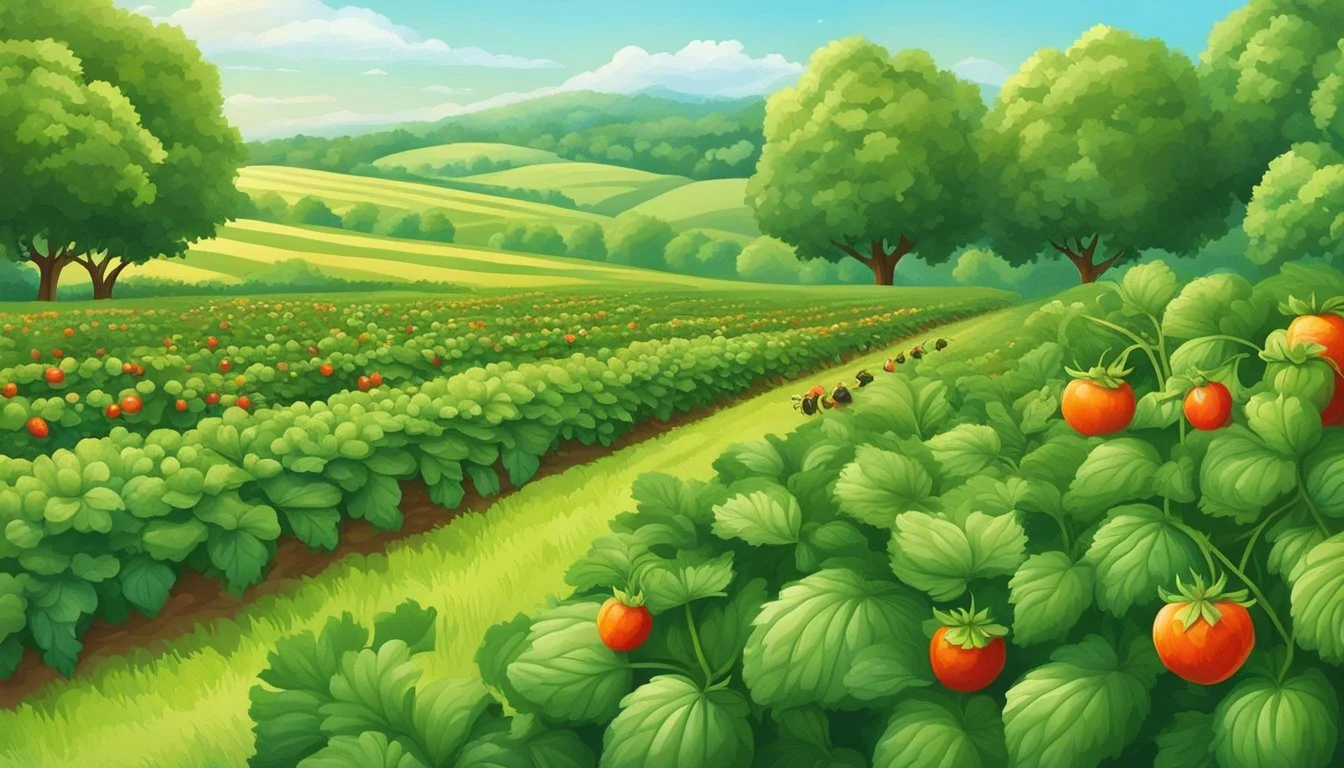Kentucky Seasonal Fruit & Vegetables in June
Your Fresh Guide
This Article is Part of our Kentucky Seasonal Fruit & Veg Calendar
June in Kentucky signals the arrival of summer and with it comes a lush bounty of seasonal fruits and vegetables. During this time, local farms and markets brim with fresh produce, making it an ideal month for food enthusiasts and home cooks to explore the richness of Kentucky's agricultural offerings. The warmer temperatures and longer days present optimal growing conditions for a variety of crops, ensuring that tables across the state are adorned with vibrant, nutrient-rich food choices.
The selection of fruits in June includes sweet, succulent treasures such as blackberries (how long do blackberries last?)and blueberries (how long do blueberries last?), prized for their rich flavors and antioxidant properties. Vegetables also take center stage with a wide availability of crisp, fresh options. Snow peas reach their peak, providing a sweet and crunchy addition to dishes, while broccoli and cabbage offer versatility, from raw salads to comforting cooked meals (how long do cooked meals last?). The start of June marks the end of the asparagus season, while beets (how long do beets last?) and other root vegetables begin to make more prominent appearances.
Kentucky's distinct seasons profoundly influence the availability of its produce, and June's offerings are reflective of this transition from spring to summer. Shoppers and chefs alike relish this time of year for the opportunity to incorporate an abundance of local produce into their gastronomic creations. The fresh flavors that define June in Kentucky are not just a testament to the state's rich soil and farming heritage, but also an invitation to savor the season's freshest picks.
Common Fruits In Season
June in Kentucky marks a bountiful period for fresh fruit, where one can find a variety of berries, stone fruits, and melons at their peak. These fruits not only provide a burst of flavor but also contribute to a colorful and healthy diet.
Berries
Strawberries: The strawberry season culminates in early June, offering the last chance to enjoy these sweet and juicy fruits.
Blueberries: They begin to ripen in June, providing a fresh, antioxidant-rich treat.
Blackberries: Also coming into season, blackberries are perfect for both fresh eating and preserves.
Stone Fruits
Peaches: Starting to become available, peaches represent the quintessence of summer with their fuzzy skin and succulent flesh.
Cherries (how long do cherries last?): Cherries are at their prime in Kentucky, ready to be picked and savored.
Apricots: While less common, apricots also contribute to the array of stone fruits ripe for the picking this month.
Melons
Watermelon: Watermelons start to signal the onset of summer, slowly making their way to local markets.
Cantaloupes (how long does cantaloupe last?): With a fragrant and sweet taste, cantaloupes begin their season, adding to the diverse selection of fresh fruits available.
Popular Vegetables Harvested
In Kentucky, June marks a productive time for harvesting a range of vegetables. The warmth and longer daylight hours contribute to the vigorous growth of various vegetable groups, including leafy greens, nightshades, and podded vegetables, each offering fresh tastes and nutritional benefits.
Leafy Greens
June brings a bounty of leafy greens such as:
Lettuce: Crisp and refreshing, lettuce thrives in the early summer days.
Kale: Hardy and nutrient-dense, kale peaks in flavor.
Spinach: Tender in texture, spinach is harvested before the summer heat intensifies.
Collards: These are best picked young for a milder taste.
Arugula: (how long does arugula last?) With its peppery note, arugula is a favorite for salads.
Nightshades
The nightshade family offers vibrant flavors with vegetables like:
Tomatoes: Beginning to ripen, they add freshness to dishes.
Peppers: Available in a spectrum of colors, each with its distinctive taste.
Eggplant: Known for its glossy skin and meaty texture, it starts appearing in markets.
Podded Vegetables
Podded vegetables are at their peak and include:
Peas: Their sweetness is unparalleled when freshly harvested.
Green Beans: Snapped green beans are crisp and ready for a multitude of recipes.
Snow Peas: Enjoyed whole, these are succulent and mildly sweet.
Herbs and Other Plant Foods
In June, Kentucky's gardens brim with a variety of root vegetables and culinary herbs, each offering fresh flavors for the season. These garden offerings allow for a multitude of culinary applications, from the sharp bite of raw radishes to the aromatic accent of fresh-picked herbs.
Root Vegetables
Kentucky's soil yields a bounty of nutritious root vegetables. By June, radishes are typically at their peak, offering a crisp, peppery flavor perfect for salads or garnishes. Carrots also enter their prime in June, with their sweet, earthy taste and satisfying crunch. Additionally, beets, although they can often be found earlier, continue to flourish, bringing earthy sweetness and vibrant color to the table.
Culinary Herbs
The warmth of June coaxes a vivid array of culinary herbs from the fertile Kentucky soil. Local gardens and markets are abundant with favorites such as:
Basil: Lush and aromatic, pairing well with both sweet and savory dishes.
Mint: Refreshing and cool, ideal for beverages, desserts, or as a palate cleanser.
Parsley: Bright and slightly peppery, a versatile garnish that complements most flavors.
Cilantro: Offers a citrusy and tangy kick, perfect for salsas and Asian cuisines.
These herbs not only enhance flavor profiles but also bring a touch of freshness to each meal created with them. Their peak freshness in June ensures the highest quality for culinary use.
Kentucky's Agriculture Profile
Kentucky's position as a provider of fresh produce is reinforced in the summer months with an abundance of fruits and vegetables. The state's diverse agricultural sector and adaptable farmers rise to the occasion, despite the challenges posed by local growing conditions and market pressures.
Farmers and Markets
In Kentucky, the summer brings a bustling scene of farmers and markets connecting to supply and distribute seasonal produce. Farmers across the state converge at community markets, where they sell directly to consumers, fostering a close relationship between growers and buyers. Cities like Louisville and Lexington host farmers markets renowned for their wide variety of local fruits and vegetables, direct from farm to table.
Growing Conditions
Kentucky falls within Hardiness Zones 6 and 7, which presents a unique set of growing conditions advantageous for a range of crops. The state's fertile soil and climate allow farmers to cultivate a variety of fruits and vegetables during the summer. However, they must continuously monitor and combat potential threats such as disease and hunger from pests, which can be a significant concern in these months.
Harvest Challenges
The farmers in Kentucky often face challenges during the harvest season. The state's summer can bring about unpredictable weather patterns, which may affect the yield and quality of produce. Farmers must be adept at managing these risks to ensure a steady supply of fruits and vegetables. Additionally, they must stay informed about the latest agricultural practices to combat diseases and mitigate the impact of pests on their crops.
By maintaining a confident and knowledgeable approach, Kentucky's farmers continue to thrive, contributing essential fresh produce to the state's economy and the fight against hunger.
Preparing Seasonal Picks
In June, the bounty of Kentucky offers an array of fruits and vegetables perfect for fresh salads, hearty meals, and sweet desserts. Utilizing these seasonal picks not only enhances flavor but also supports local produce.
Fresh Salad Recipes
A crisp salad featuring lettuce and greens provides a refreshing dish on a hot day. To celebrate the season's offerings, one might combine raw spinach and kale topped with slices of tomatoes, cucumbers, and peppers for a burst of flavor. Dressing such salads with a light vinaigrette can complement the fresh taste of the produce.
Bean Salad with Peppers and Tomatoes: Toss together fresh beans, diced peppers, and cherry tomatoes with a tangy balsamic dressing.
Kentucky Garden Salad: Mix assorted lettuce and greens, garnish with radishes, and add a handful of berries for a sweet touch.
Hearty Meal Ideas
Kentucky's seasonal vegetables lend themselves to savory dishes that can satisfy any appetite. Eggplant and peppers can be grilled or roasted to draw out their natural richness, making them perfect for a vegetable medley or as the star of a plant-based entrée.
Grilled Vegetables: Combine slices of eggplant, peppers, and tomatoes brushed with olive oil and herbs before grilling.
Stewed Beans: Slow-cook beans with onions and a rich tomato sauce for a comforting, nutritious meal.
Sweet Treats
As summer approaches, the sweetness of peaches, berries, and melons become available and are perfect for desserts. Homemade pies and ice cream featuring these fruits can be an ideal way to enjoy Kentucky’s seasonal fruits.
Berry Pies: Bake a mixed berry pie with a lattice crust to allow the vibrant flavors to shine.
Peach Ice Cream: Create a homemade ice cream infused with the essence of ripe peaches.
Melon Cocktails: Craft refreshing cocktails using pureed melon, a splash of spirits, and a sprig of mint.
Incorporating these ingredients into June's menu can make dining a delightful seasonal experience.
Preserving Seasonal Abundance
In June, Kentucky's harvest undergoes a vibrant transformation, offering an array of fruits and vegetables ripe for preservation. Canning is a traditional method where produce like beets, blackberries, and green onions can be sealed in sterilized jars to retain freshness. This ensures a taste of summer can be savored during the fall and winter months.
Freezing is another effective way to preserve the June bounty. It is ideal for fruits such as blackberries and blueberries. When frozen promptly at peak ripeness, they maintain their nutritional value and flavor. Vegetables like snap beans and bok choy can also be blanched and frozen for later use.
For drying, one can leverage the natural warmth of Kentucky’s June weather. Herbs and sturdy greens, easily dehydrated, can be stored in airtight containers and used throughout the year, adding a dash of summer to various dishes.
Individuals can successfully preserve their harvest using these methods, which are straightforward and cost-effective. Below is a quick guide to what can be preserved and by which method:
Fruit or Vegetable Canning Freezing Drying Beets ✓ ✓ Blackberries ✓ ✓ ✓ Blueberries ✓ ✓ Bok Choy ✓ Green Onions ✓ ✓
By preserving food, individuals not only extend the shelf life of seasonal produce but also ensure that the flavor and nutritional value are locked in for future enjoyment, regardless of the season.
Benefits of Eating Locally and Seasonally
Eating locally and seasonally garners a mosaic of benefits, which encompass not only personal health and flavor but also the local economy and environment.
When Kentuckians choose local produce in June, flavor is notably enhanced. Seasonal fruits and vegetables are harvested at peak ripeness, meaning they have developed their fullest natural taste. Tomatoes, for instance, are sweeter and juicier, while cucumbers are more crisp and refreshing.
From a health benefits perspective, seasonal produce is also superior. Nutrients are most abundant when the produce is fresh. The shorter the time between the garden and the table, the fewer vitamins and minerals are lost, bolstering one's dietary intake.
Availability is another perk. Local crops like berries and leafy greens are plentiful in June, ensuring consumers have access to a wide variety, which encourages a diverse diet.
The economic impact should not be understated. Purchasing local produce supports Kentucky's farmers and sustains the agricultural community. This act circulates money within the local economy and contributes to job creation.
In summary, the act of choosing locally-grown, seasonal produce is a simple choice with far-reaching positive effects. Patrons enjoy better flavors and health benefits, while the community thrives economically, and the carbon footprint is minimized through reduced transport distances.








